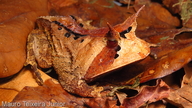|
Proceratophrys laticeps Izecksohn & Peixoto, 1981
| family: Odontophrynidae genus: Proceratophrys |
 © 2018 Mauro Teixeira Jr (1 of 5) |
|
|
|
Description Proceratophrys laticeps is very similar in appearance to P. appendiculata and P. boiei, although P. laticeps can be distinguished by a wider head (Izecksohn and Peixoto 1981). Distribution and Habitat Country distribution from AmphibiaWeb's database: Brazil
Life History, Abundance, Activity, and Special Behaviors Proceratophrys tadpoles develop in slow-flowing water (Peixoto et al. 1981). Proceratophrys laticeps has been found sympatrically with P. paviotii and P. boiei, vocalizing in sandy streambeds (Cruz et al. 2005). Males congregate to call (Izecksohn and Peixoto 1996). Larva
References
Cruz, C. A. G., Prado, G. M., and Izecksohn, E. (2005). ''Nova espécie de Proceratophrys Miranda-Ribeiro, 1920 do sudeste do Brasil (Amphibia, Anura, Leptodactylidae).'' Arquivos do Museu Nacional, Rio de Janeiro, 63, 289-295. Izecksohn, E., and Peixoto, O. L. (1981). ''Nova especie de Proceratophrys, da hileia bahiana, Brasil (Amphibia, Anura, Leptodactylidae).'' Revista Brasileira de Biologia, 41, 19-24. Izecksohn, E., and Peixoto, O. L. (1996). ''Uma grande concentração de individuos de Proceratophrys laticeps (Amphibia, Anura, Leptodactylidae).'' Revista da Universidade Federal Rural do Rio de Janeiro, Série Ciência e Vida, 18, 105-107. Peixoto, O. L., Izecksohn, E., and da Cruz, C. A. G. (1981). ''Notas sobre o girino de Proceratophrys laticeps Izecksohn & Peixoto (Amphibia, Anura, Leptodactylidae).'' Revista Brasileira de Biologia, 41, 553-555. de Sá, R. O., and Langone, J. A. (2002). ''The tadpole of Proceratophrys avelinoi (Anura: Leptodactylidae).'' Journal of Herpetology, 36, 490-494. Edited by: Michelle S. Koo (2022-08-15) Species Account Citation: AmphibiaWeb 2022 Proceratophrys laticeps <https://amphibiaweb.org/species/5626> University of California, Berkeley, CA, USA. Accessed Jun 6, 2025.
Feedback or comments about this page.
Citation: AmphibiaWeb. 2025. <https://amphibiaweb.org> University of California, Berkeley, CA, USA. Accessed 6 Jun 2025. AmphibiaWeb's policy on data use. |



 Map of Life
Map of Life